八年级英语上册Unit1Wheredidyougoonvacation教案(新版)人教新目标版
- 格式:doc
- 大小:60.50 KB
- 文档页数:5
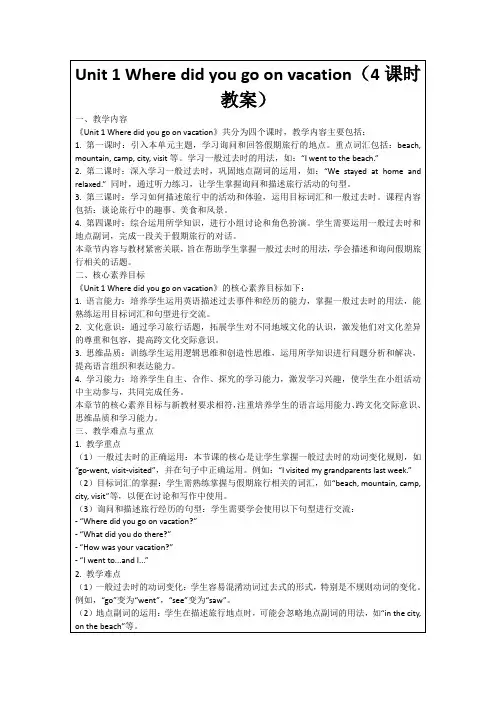

《八年级英语Unit1Where did you go on vacation?》教学设计一、教学目标1.掌握本单元的重点词汇和短语,如:go on vacation,stay at home,go tothe beach等。
2.学会运用一般过去时询问和描述过去的活动和经历。
3.提高学生的听说读写综合能力。
二、教学重难点1.重点:一般过去时的用法和本单元的词汇短语。
2.难点:用英语准确描述过去的经历。
三、教学方法情景教学法、任务型教学法、小组合作学习法。
四、教学过程1.导入(1)播放一段关于旅游的视频,引出话题“vacation”。
(2)提问学生:“What did you do on your last vacation?”2.词汇学习(1)展示本单元的词汇图片,教授新词汇。
(2)让学生进行词汇拼写和发音练习。
3.听力训练(1)播放课本听力材料,让学生完成听力任务。
(2)检查答案,讲解听力中的重点内容。
4.对话练习(1)让学生两人一组,根据课本对话范例进行对话练习,询问彼此的假期活动。
(2)邀请几组学生进行对话展示。
5.阅读教学(1)让学生阅读课本中的短文,理解文章内容。
(2)提出问题,让学生回答,检查阅读效果。
6.写作训练(1)让学生写一篇关于自己假期经历的短文。
(2)教师巡视,给予指导。
(3)选取几篇学生的作文进行点评。
7.总结归纳(1)总结本单元的重点词汇和短语。
(2)强调一般过去时的用法。
8.作业布置(1)完成课后练习。
(2)用英语向家人或朋友描述自己的一次假期经历。
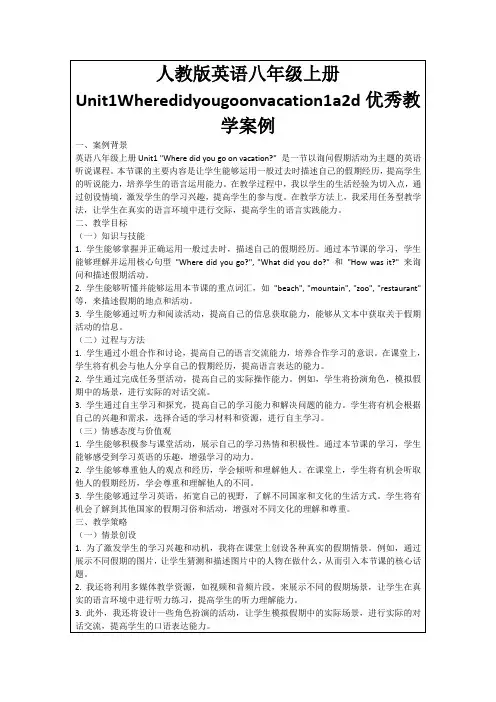
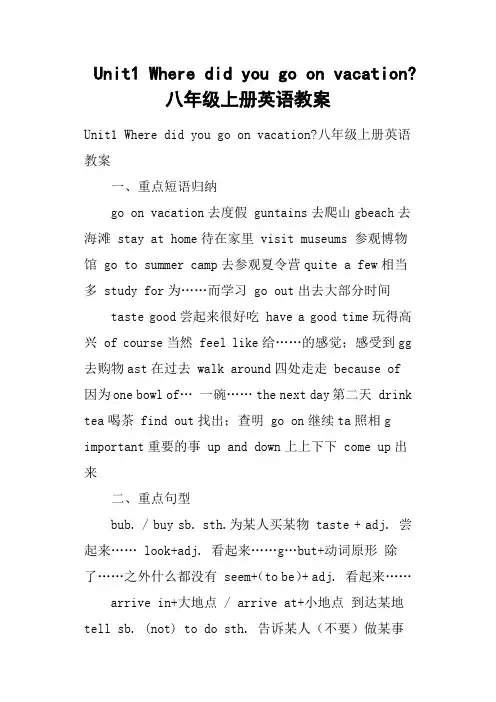
Unit1 Where did you go on vacation?八年级上册英语教案Unit1 Where did you go on vacation?八年级上册英语教案一、重点短语归纳go on vacation去度假 guntains去爬山gbeach去海滩 stay at home待在家里 visit museums 参观博物馆 go to summer camp去参观夏令营quite a few相当多 study for为……而学习 go out出去大部分时间taste good尝起来很好吃 have a good time玩得高兴 of course当然 feel like给……的感觉;感受到gg 去购物ast在过去 walk around四处走走 because of因为one bowl of… 一碗…… the next day第二天 drink tea喝茶 find out找出;查明 go on继续ta照相g important重要的事 up and down上上下下 come up出来二、重点句型bub. / buy sb. sth.为某人买某物 taste + adj. 尝起来…… look+adj. 看起来……g…but+动词原形除了……之外什么都没有 seem+(to be)+ adj. 看起来…… arrive in+大地点 / arrive at+小地点到达某地tell sb. (not) to do sth. 告诉某人(不要)做某事doing sth.尝试做某事 /do sth.尽力去做某事 decide to do sth.决定去做某事get doing sth.忘记做过某事/ forget to do sth.忘记做某事doing sth.喜欢做某事want to do sth.想去做某事 start doing sth.开始做某事doing sth. 停止做某事 dislike doing sth. 不喜欢做某事 keep doing sth.继续做某事Why not do. sth.?为什么不做……呢?so+adj.+that+从句如此……以至于……三、重点、难点、考点精讲(一)A1.Where did you go on vacation?你去哪里度假了?(P1)1)这是有疑问副词where引导的特殊疑问句,where 用来询问地点和场所,放在句首,其后跟一般疑问句。
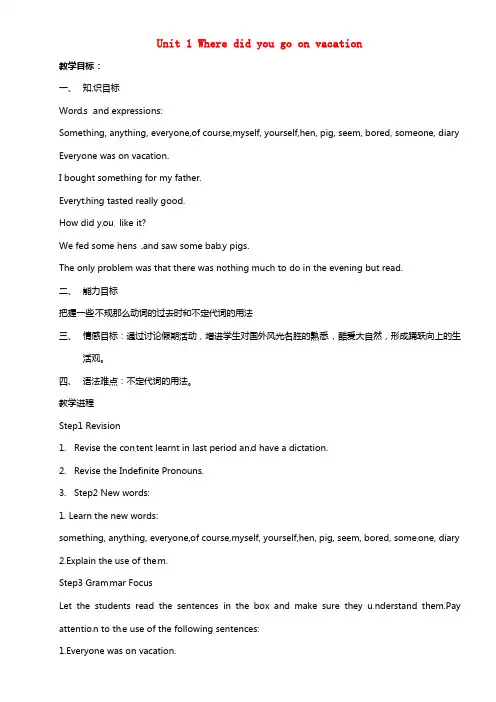
Unit 1 Where did you go on vacation教学目标:一、知识目标Word s and expressions:Something, anything, everyone,of course,myself, yourself,hen, pig, seem, bored, someone, diary Everyone was on vacation.I bought something for my father.Everyt hing tasted really good.How did y ou like it?We fed some hens and saw some bab y pigs.The only problem was that there was nothing much to do in the evening but read.二、能力目标把握一些不规那么动词的过去时和不定代词的用法三、情感目标:通过讨论假期活动,增进学生对国外风光名胜的熟悉,酷爱大自然,形成踊跃向上的生活观。
四、语法难点:不定代词的用法。
教学进程Step1 Revision1.Revise the con tent learnt in last period an d have a dictation.2.Revise the Indefinite Pronouns.3.Step2 New words:1. Learn the new words:something, anything, everyone,of course,myself, yourself,hen, pig, seem, bored, some one, diary 2.Explain the use of the m.Step3 Gram mar FocusLet the students read the sentences in the box and make sure they u nderstand them.Pay attentio n to th e use of the following sentences:1.Everyone was on vacation.2.I bought somethin g for my father.3.Everything tasted really good.Step4 3a1.Let the stud ents fill in the blanks in the box ,paying attention to the use of Indefinitepronouns.2.C heck the answers.3.Students recite the conversation.Step5 3b1.Le t the students f ill in the blanks in the box ,payin g attention to the use of Indefinite pronouns.2.Check the answers.3.Explain the follow ing:(1.)We fed some hens and saw some baby pigs.(2.)The only problem w as that there was nothing much to d o in the evening but r ead.nothing to do bu t do…4.Students recite the e-mail message.Step6 3c Practice1.Let the students ask their group questions about their last vacation,fill in th e chart.2.Tell the class their results.Step 7 Test1.Dictate the new words.2.Translate the following sentences:1.每一个人都在度假。
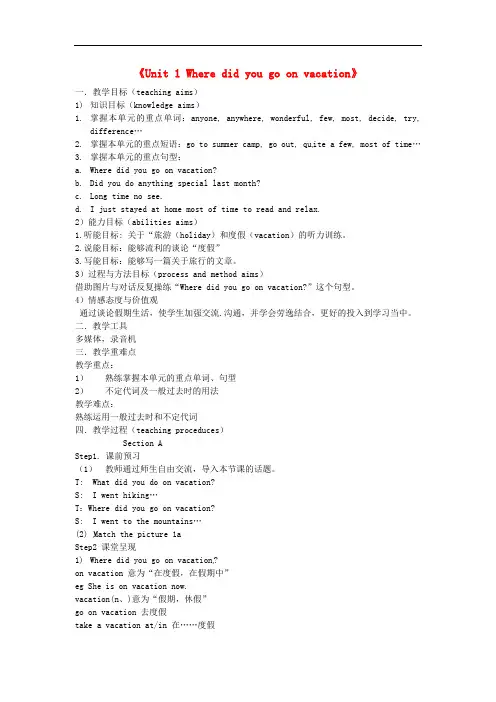
《Unit 1 Where did you go on vacation》一.教学目标(teaching aims)1)知识目标(knowledge aims)1.掌握本单元的重点单词:anyone, anywhere, wonderful, few, most, decide, try,difference…2.掌握本单元的重点短语:go to summer camp, go out, qu ite a few, most of time…3.掌握本单元的重点句型:a.Where did you go on vacation?b.Did you do anything special last month?c.Long time no see.d.I just stayed at home most of time to read and relax.2)能力目标(abilities aims)1.听能目标: 关于“旅游(holiday)和度假(vacation)的听力训练。
2.说能目标:能够流利的谈论“度假”3.写能目标:能够写一篇关于旅行的文章。
3)过程与方法目标(process and method aims)借助图片与对话反复操练“Where did you go on vacation?”这个句型。
4)情感态度与价值观通过谈论假期生活,使学生加强交流.沟通,并学会劳逸结合,更好的投入到学习当中。
二.教学工具多媒体,录音机三.教学重难点教学重点:1)熟练掌握本单元的重点单词、句型2)不定代词及一般过去时的用法教学难点:熟练运用一般过去时和不定代词四.教学过程(teaching proceduces)Section AStep1. 课前预习(1)教师通过师生自由交流,导入本节课的话题。
T: What did you do on vacation?S: I went hiking…T:Where did you go on vacation?S: I went to the mountains…(2) Match the picture 1aStep2 课堂呈现1)Where did you go on vacation?on vacation 意为“在度假,在假期中”eg She is on vacation now.vacation(n、)意为“假期,休假”go on vacation 去度假take a vacation at/in 在……度假2)…go with anyone?……和别人去的吗?anyone 不定代词,相当于anybody.用于肯定句当中,意为“任何人”,用于否定句和疑问句中时,意为“有人”,作主语时,谓语动词用单数形式。

八年级英语上册Unit1Wheredidyougoonvacation-写作课教案八年级英语上册Unit 1 Where did you go on vacation?写作课教案I. Teaching Aims:1. Knowledge aims:Key words and phrases: Tian’anmen SquaPalace Museum, a Beijing hutong,leag important , Beijing du: Did you dislike anything?What did you like best?How did you feel abou?2. Ability aims: Ss talk abouvacaast usingUvwriting skillal aims: Ss exchanglings by talking about vacations and gw more abouII. Teaching important and difficulvise and maand phrauvwriting skill.. Teaching Aids: mufti-mediaTeaching ProcedureTeacher’ s activ’ activitiesPurposes<="" dvacaan="" exd="" jane="" kinds="" lead-in="" of="" p="" say="" say:="" she="" two="" what="" wwent="" you="">Ss read Jane’s diary in a loud voice, llawent andgs she did.To hellidawledgave learneddiaries <="">Imagine we’re all foreigvacaa. Waat the aur waTalk about what we did on our vacation l: Hi, Paul. I’m Anna. Did you go anywg? Where did you go on vacation? Did you do anythingg? What did you do? Did you go with anyone? Did evave a good time? Did you buy anything specialganyone? Say: Do you knowuversations? Plealwaake conversations. Theyshoulduuversations, andaversalass. TlTo hellidate the usaguBrag Say: Exquabove, when we talk about our vacations, we can aNow let’s list quas many as we can. Ask: Can you ask any new question? Let’s compare your quwqub. Ss lquabout vacaave learned as many aaad the qub, find at the qud.To helaucture and consolidawledgWb. Say: Let’s wairs, ask and answquairs. Say: Let’s share your vacations.Ss act ougive aaccordingaavaking and listening skills. To help Ssdevelop good listening habWa Say: If we put the answb toga diary. Here is a diary in 3a. Please fillblanks.(Teaalaces) Ask: How to write a diary l? Now let’s revise how to write a diary. Say: When we write a diary about our vacation, weneedduce “where, what, how”. The word “how” includes our feelings, the wealeaalaces and fillblanks wwordbox.<="">To hellidauctuavel diary and get ready for writingWay: Look at 3c .Let’s write a travel diary and share your vacawrite a travel diary like Jane’adiavwriting skillHomework Readwn travel diaries again and find out mistakes。
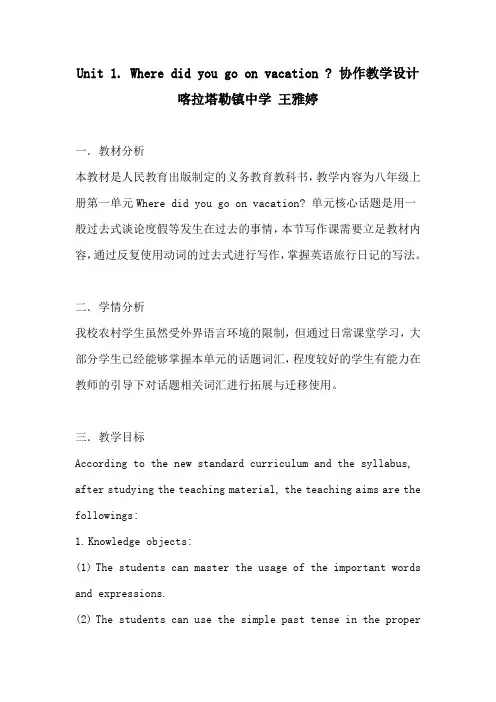
Unit 1. Where did you go on vacation ? 协作教学设计喀拉塔勒镇中学王雅婷一.教材分析本教材是人民教育出版制定的义务教育教科书,教学内容为八年级上册第一单元Where did you go on vacation? 单元核心话题是用一般过去式谈论度假等发生在过去的事情,本节写作课需要立足教材内容,通过反复使用动词的过去式进行写作,掌握英语旅行日记的写法。
二.学情分析我校农村学生虽然受外界语言环境的限制,但通过日常课堂学习,大部分学生已经能够掌握本单元的话题词汇,程度较好的学生有能力在教师的引导下对话题相关词汇进行拓展与迁移使用。
三.教学目标According to the new standard curriculum and the syllabus, after studying the teaching material, the teaching aims are the followings:1.Knowledge objects:(1)The students can master the usage of the important words and expressions.(2)The students can use the simple past tense in the propersituation.(3)The students can understand the content of the lesson, talk about holidays and vacations and get their own ideas about how to keep an English diary about travelling.2.Ability objects:(1)To develop the students’ abilities of listening, speaking, reading and writing.(2)To guide students to set up effective studying strategies.(3)To improve the students’ writing ability.3.Emotion or moral objects:By completing the task, Students increase their interest in travelling and set up self-confidence in Chinese Culture.四.教学重难点Based on the requirement of syllabus.The important points is the usage of the simple past tense, such as the correct forms of the regular and irregular verbs. The difficult points are the English writing structures and skills, such as the logical order and the conjunctions.五.教学方法As is known to us all, a good teaching method requires that theteacher should help students develop good sense of the English language. For achieving these teaching aims,I will use the following methods according to the modern social communication teaching theories.(1)Communicative approach(2)Total Situational Action六.教学过程Step1. Lead inDiscuss the Pictures on RMB including the scenery spots and the exact places.100-The great hall of the people 50-the Po-tala Palace20-Guilin Scenery10-Three Gorges 5-Mount Tai 1-Three Pools Mirroring the Moon 设计意图:从学生所熟悉的实物入手,激发学生开口说英语的兴趣,引导学生说出旅游见到的基本元素及地理位置,再看中华山水与实际生活的完美结合,激发学生对祖国文化的自信,逐步进入主题。
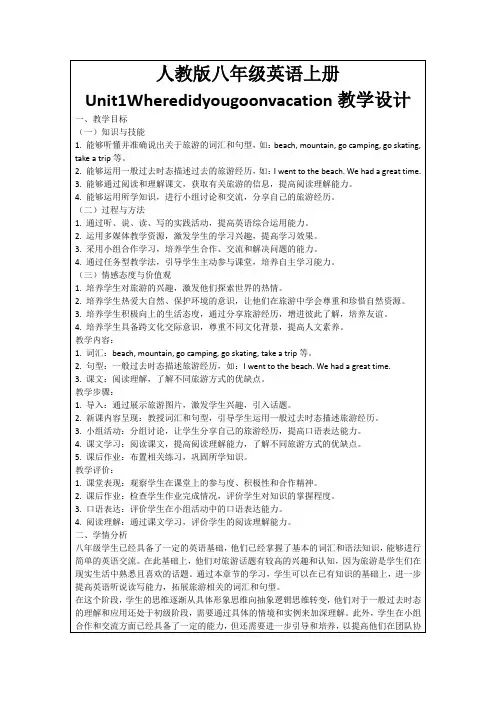
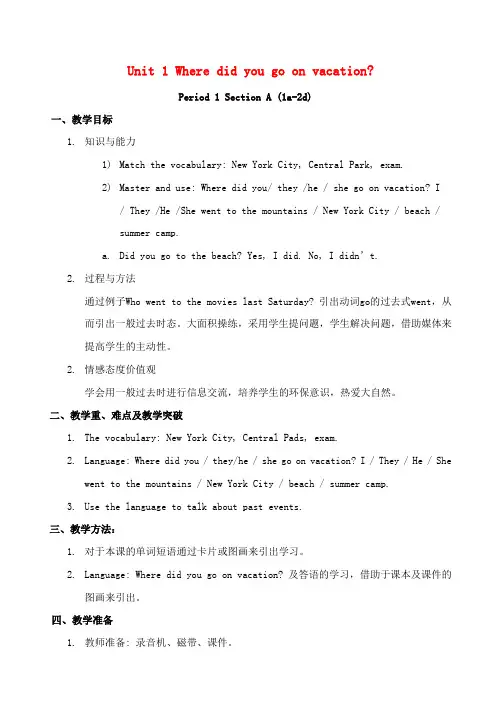
Unit 1 Where did you go on vacation?Period 1 Section A (1a-2d)一、教学目标1.知识与能力1)Match the vocabulary: New York City, Central Park, exam.2)Master and use: Where did you/ they /he / she go on vacation? I/ They /He /She went to the mountains / New York City / beach /summer camp.a.Did you go to the beach? Yes, I did. No, I didn’t.2.过程与方法通过例子Who went to the movies last Saturday? 引出动词go的过去式went,从而引出一般过去时态。
大面积操练,采用学生提问题,学生解决问题,借助媒体来提高学生的主动性。
2.情感态度价值观学会用一般过去时进行信息交流,培养学生的环保意识,热爱大自然。
二、教学重、难点及教学突破1.The vocabulary: New York City, Central Pads, exam.nguage: Where did you / they/he / she go on vacation? I / They / He / Shewent to the mountains / New York City / beach / summer camp.e the language to talk about past events.三、教学方法:1.对于本课的单词短语通过卡片或图画来引出学习。
nguage: Where did you go on vacation? 及答语的学习,借助于课本及课件的图画来引出。
四、教学准备1.教师准备: 录音机、磁带、课件。

Unit1Wheredidyougoonvacation一、教材分析Unit1Wheredidyougoonvacation?的核心话题为“Talkingaboutholidays,vacationsandpastevents”,主要描述有关假期等过去的事情,学习和运用一般过去时,使学生学会谈论和交流过去发生的事情,让学生在交际活动中学会如何正确用英语谈论自己及询问他人过去的事情与经历,重在培养学生的语言运用能力、实践能力、合作能力及创新意识。
二、教学目标1.知识目标:1)掌握并能灵活运用本单元出现的重点词汇。
动词及它的过去式:stay(ed),visit(ed),go(went),do(did),is/am(was)2)用“Wheredidyougo...?Didyou...?”询问他人过去的经历。
3)掌握以下句式:(1)—Wheredidsb.go(onvacation)?—Sb.+wentto…(onvacation).(2)—Whatdidsb.do(onvacation)?—Sb.+verb+ed…(onvacation).(3)一般过去时的应用。
2.能力目标:学会谈论发生在过去的事情;能听懂以谈论假期做过的事情和谈论过去的事件及自己的感想为话题的语言材料,并获取相关信息。
能以“Talkingaboutholidaysandvacations”,“Talkingaboutpastevents”为话题与他人进行交流;能利用该话题进行情景对话及角色表演。
3.情感目标:本单元的教学内容与学生的实际生活息息相关,容易激发学生的兴趣,从而乐于运用简单的英语与他人进行交流。
学习活动中学生通过交换对过去发生的事情的描述及看法,从而促进学生之间和师生之间的情感交流,增进友谊。
三、重点和难点1.一般过去时及其应用。
注意:本课难点是动词过去式要加“ed”,而学生在描述过去时时容易遗忘动词的“ed”,在运用不规则动词过去式时容易直接加“ed”.2.运用一般过去时描述自己的假期情况及过去的事情。
Unit 1 Where did you go on vacation?教材解读本单元的核心话题是用一般过去时谈论度假等发生在过去的事情。
因此“Where did you go on vacation?”“Did you go to the beach?Yes,I did/No,I didn’t.”等是教学的重点。
通过对本单元的学习,学生能把握本单元消灭的地点名词,用于询问和答复过去发生的事情的短语和句型。
单元目标一、学问与技能1.词汇:New York City, Central Park, exam, were, rainy, delicious,expensive, inexpensive, crowded, flew, kite, later, felt, little, corner, discuss, etc.2.句型: Where did you go on vacation? I went to summer camp.Did she go to Central Park?Yes, she did.No, she didn’t.3.语法:一般过去时的特别疑问句、一般疑问句及肯、否认答复。
4.力量目标:能用一般过去时娴熟谈论假期发生的事。
二、过程与方法机敏运用教材,从所教学生的实际水平和语言力量动身,调整和取舍教学内容,合理安排本单元的课时数,设计好每课时的教学内容。
三、情感、态度与价值观1.通过描述假期发生的事,增进同学间的了解,增进感情。
2.通过图片和视频欣赏美丽的风景,培育宠爱祖国大好河山的思想感情,提高学生的环保意识。
3.了解自己的力量,培育情操4.培育学生们对英语的兴趣。
教法导航1.以任务型教学作为课堂教学理念、利用整体语言教学法、情景教学法、交际教学法等。
2.在教学中创设切实可行的任务型教学活动、突出交际性。
3.教师为主导、学生为主体、任务为根底,留意有用性。
4.引趣激趣策略,创设情景调整气氛,引发激发学生兴趣。
Unit 1 Where did you go on vacation?Section A 1 (1a-2d)一、教学目标:1. 语言知识目标:1) 能掌握以下单词:anyone, anywhere, wonderful, quite a few, most, something, nothing, everyone, of course, myself, yourself能掌握以下句型:①—Where did you go on vacation? —I went to the mountains.②—Where did Tina to on vacation? —She went to the beach.③—Did you go with anyone? —Yes, I did./No, I didn’t.2) 能了解以下语法:—复合不定代词someone, anyone, something, anything等的用法。
—yourself, myself等反身代词的用法。
3)一般过去时态的特殊疑问句,一般疑问句及其肯定、否定回答。
2. 情感态度价值观目标:学会用一般过去时进行信息交流,培养学生的环保意识,热爱大自然。
二、教学重难点1. 教学重点:1) 用所学的功能语言交流假期去了什么旅行。
2) 掌握本课时出现的新词汇。
2. 教学难点:1) 复合不定代词someone, anyone, something, anything等的用法。
2) yourself, myself等反身代词的用法。
三、教学过程Ⅰ. Lead-in1. 看动画片来进入本课时的主题谈论上周末做了些什么事情,谈论过去发生的事情。
Ⅱ. Presentation1. Show some pictures on the big screen. Let Ss read the expressions.2. Focus attention on the picture. Ask: What can you see? Say: Each picture shows something a person did in the past. Name each activity and ask students to repeat: Stayed at home, Went to mountains, went to New York City 6. Went to the beach,visited my uncle, visited museums, went to summer camp3. Now, pleas e match each phrase with one of the pictures next to the name of the activity,point to the sample answer.4. Check the answers. Answers: 1. f 2. b 3. g 4. e5. c6. a7. dIII. Listening1. Point to the picture on the screen.Say: Look at the picture A. Where did Tina go on vacation? She went to mountains. Ask: What did the per son do in each picture?2. Play the record ing the first time.3. Play the recording a second time.Say: There are three conversations. The people talk about what did on vacation. Listen to the recording and write numbers of the names in the right boxes of the picture.4. Check the answers.IV.Pair work1. Point out the sample conversation. Ask two Ss to read the conversation to the class.2. Now work with a partner. Make your own conversation about the people in the picture.3. Ss work in pairs. As they tal k, move around the classroom and give any help they need.4. Let some pairs act out their conversations.V. Listening1. Tell Ss they will hear a conversation about three students’conversations. Listen for the first time and fill in the chart. Then listen again and check Yes, or N o.2. Let Ss read the phrase s in the chart of 2b.3. Play the recording the first time. Ss listen and fill in the chart.4. Play the recording a second tim e for the Ss to check “Yes, I did.”or “No, I didn’t. ”5. Check the answers with the Ss.VI. Pair work1. Let two Ss read the conversation between Grace, Kevin and Julie.2. Let Ss work in pairs and try to role-play the conversation.3. Ask some pairs to act out their conversations.VII. Role-play1. First let Ss read the conversation and match the people and places they went.2. Let Ss act out t he conversations in pairs.3. Some explanations in 2d.Homework:用英语询问你的一位好朋友,她(他)假期去了哪里?看到了什么?并将此对话写在作业上。
Unit 1 Where did you go on vacation?
Ⅰ.Analysis of teaching materials:
This unit is around "Holidays and vacation”to carry out teaching activities.Students should learn to use past tense to talk about holiday activities.
The content is close to students’lives,it’s also a topic that students are willing
to discuss and share with others .So in teaching process ,we can consolidate the
key sentences “Where did you go on vacation? Did you …How …”through different methods such as pair work ,acting , reporting and interviews. Students can consolidate and study further about the past tense on the basis of original.Students
can also use the past tense to write a diary about their vacations.
Ⅱ.Teaching Aims:
1.Knowledge aims:
①Ss talk about travel activities correctly using “where” and “how”.
②Ss master questions with auxiliary “did”and the answers to the questions.
③Ss learn to express their feelings correctly.
2.Ability aims::
①Ss can ask and answer questions about the things in the past using the past tense.
②Ss can use description words to express their feelings.
③Ss can record a vacation in a form of a diary and express their feelings about
the vacations.
3Emotional aims:
Ss get to know more about each other through the exchange of what they have seen,
heard and felt.
Ss learn to express their feelings in a better way.
Ⅲ.Teaching important and difficult points
1、Ss master and use the vocabulary and expressions.
2、Ss master general questions and special questions and the answers to the questions.
3、Ss master the past tense of regular and irregular verbs .
Ⅳ.Teaching arrangements
1.Section A 1a~2c 2. Section A 2d~3c 3. Section B 1a~1e 4.Section B 2a~2e 5. Review of Unit 1. 3a~Self check 2
Unit 1 Where did you go on vacation?
Period 1 Section A 1a~2c
I. Teaching Aims:
1.Knowledge aims:
Key words and phrases: New York City. Central Park anyone. anywhere interesting wonderful.
Key sentences: Where did you go on vacation?
I went to New York City.
Did you buy anything special?
Yes. I bought something special for my dad.
2.Ability aims: Students learn to discuss their vacations in the past using key sentences.
Students improve their listening and speaking skills.
3. Emotional aims: Ss exchange their feelings about their vacations and know more about each other.
II. Teaching important and difficult points
Ss master key words and sentences, then use them correctly.
Ss learn to talk about what they did in the past.
Ss improve their listening and speaking skills.
Ⅲ. Teaching Aids:
mufti-media, tape
Ⅳ. Teaching Procedure。